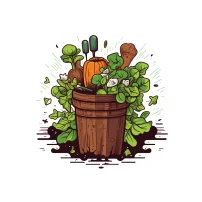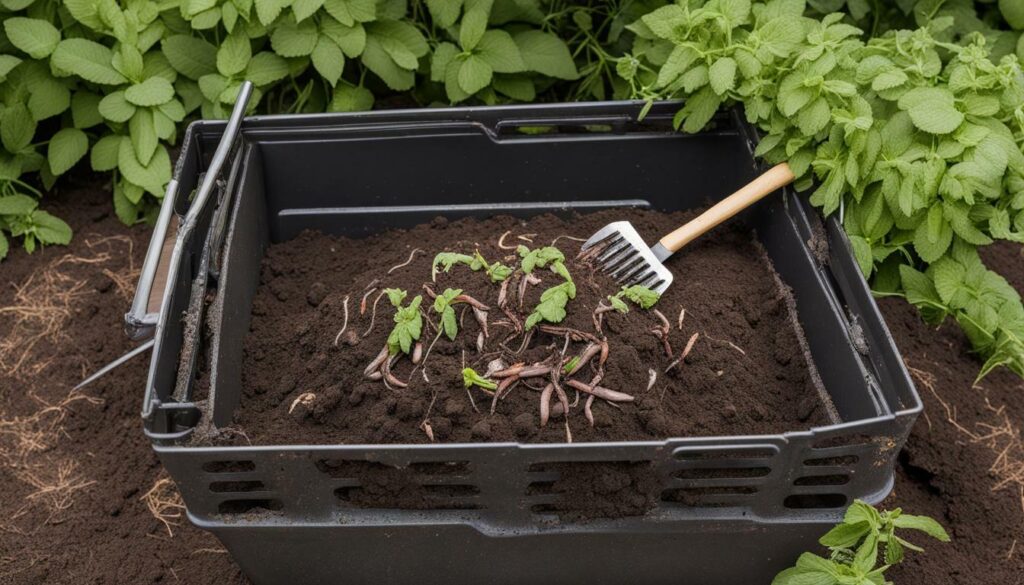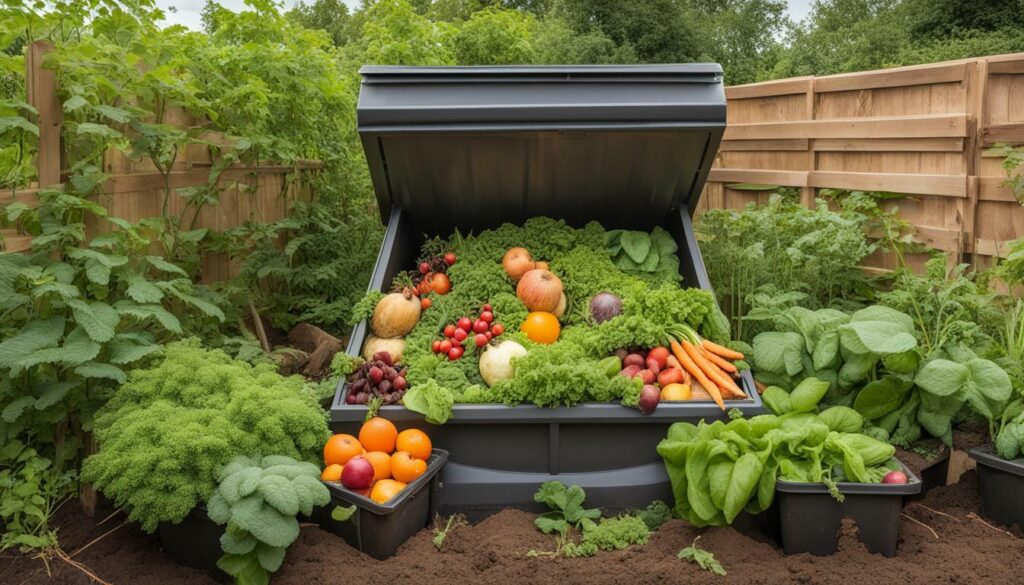Composting has become increasingly popular as people look for eco-friendly ways to manage their organic waste. Grass clippings are a common source of organic material that can be added to compost, but many people wonder if it is safe and effective to do so.
Grass clippings contain a high amount of nitrogen, an essential nutrient for plant growth. When added to compost, they can increase the nutrient content and improve soil structure. However, using grass clippings in compost can also present some challenges, such as excessive moisture and a strong odor.
In this article, we will discuss the benefits and potential challenges of using grass clippings in compost, as well as provide tips and guidelines for effective and environmentally friendly composting.
Key Takeaways
- Grass clippings are a common source of organic material for composting.
- Grass clippings are rich in nitrogen, which is essential for plant growth.
- Composting grass clippings can improve nutrient content and soil structure but can also present challenges like excess moisture and odor.
- Effective composting requires proper layering, balancing of carbon-to-nitrogen ratio, and mixing with other organic materials.
- Grass clippings can also be used as mulch or a component in garden beds.
- Composting grass clippings reduces waste volume and methane emissions, contributing to a sustainable future.
Understanding Grass Clippings for Composting
Grass clippings are a common organic waste material that can be added to a compost pile. When grass is cut, it creates small pieces of organic matter that decompose quickly and provide a rich source of nitrogen for compost. Adding grass clippings to compost can increase the nutrient content and improve soil structure, making it an excellent option for gardening and farming.
The benefits of using grass clippings for compost are numerous. The high nitrogen content in grass clippings speeds up the decomposition process and helps create a more balanced carbon-to-nitrogen ratio, which is an essential requirement for effective composting. Additionally, grass clippings can help retain moisture in soil, reducing the need for watering and promoting healthy plant growth.
Guidelines for Composting Grass Clippings
Composting grass clippings is a simple way to reduce waste and create nutrient-rich soil that can benefit your garden. To ensure that your grass clippings compost properly and do not create any unpleasant smells, you need to follow some best practices for composting. Here are some guidelines to follow:
Layering
It’s important to layer your grass clippings properly in your compost bin. Alternate between layers of grass clippings and other organic material like leaves, twigs, and fruit and vegetable scraps. This prevents clumping and encourages proper air circulation, which helps the compost break down faster.
Carbon-to-Nitrogen Ratio
The carbon-to-nitrogen ratio is an essential aspect of composting that often gets overlooked. Too much nitrogen can lead to a smelly, slimy mess, while too much carbon can slow down the decomposition process. To create an ideal ratio, aim for roughly one part greens (like grass clippings) to two parts browns (like leaves and twigs).
Mixing
Mixing your grass clippings with other organic materials is crucial for ensuring that your compost stays healthy and breaks down properly. Mixing improves air circulation and helps distribute moisture more evenly. Be sure to mix your compost every week or so to encourage proper decomposition.
Size Matters
The size of your grass clippings can impact the rate at which they compost. Smaller clippings break down faster, while larger ones take longer and can create clumps. To ensure they break down effectively, cut your grass at the right height. Keep your blade sharp to avoid tearing the grass and leaving behind long pieces.
By following these guidelines, you can compost your grass clippings effectively and create nutrient-rich soil that benefits your garden. Remember to be patient, as composting takes time, and to monitor your compost for any issues that may arise.
Avoiding Common Pitfalls
While grass clippings are a valuable addition to a compost pile, it’s important to use them in moderation. Including too many grass clippings at once can lead to dense, smelly clumps that are slow to decompose. It’s best to add grass clippings in thin layers, alternating with brown materials like leaves or shredded paper.
Another common issue when composting with grass clippings is slow decomposition. Grass clippings have a high moisture content and can easily become matted down, preventing air from circulating through the pile. To avoid this problem, it’s important to mix grass clippings with other materials and turn the pile regularly. Using a compost thermometer to monitor the temperature can also ensure that the pile is breaking down properly.
Finally, it’s important to avoid composting grass clippings that have been treated with pesticides or herbicides. These chemicals can persist in the compost and harm plants when it is used as a soil amendment. To be safe, only compost grass clippings from lawns that have not been chemically treated.
Tips for Using Grass Clippings in Compost
Composting grass clippings is a great way to reduce waste and create a nutrient-rich soil. Here are some tips to effectively use grass clippings in compost:
- Dry the grass clippings: Allow the grass clippings to dry out for a day or two before adding them to the compost pile. This will prevent clumping and improve the airflow in the pile.
- Cut grass to the right height: Mow your lawn at the right height to produce ideal clippings for composting. Cutting no more than one-third of the grass blade at a time ensures healthy regrowth for the lawn and optimal compost material.
- Balance the carbon-to-nitrogen ratio: Add the right amount of grass clippings to the compost pile to prevent excessive nitrogen levels that can lead to odors and slow decomposition. Use other organic materials, such as leaves or sticks, to balance the carbon-to-nitrogen ratio.
- Mix the materials: Mix the grass clippings with other organic materials to ensure even distribution and efficient decomposition. This also helps avoid clumping and the formation of anaerobic pockets in the pile.
- Monitor the temperature: Use a compost thermometer to monitor the temperature of the pile regularly. The ideal temperature range for composting is between 135°F and 160°F. If the temperature drops below or exceeds this range, adjust the materials accordingly.
By following these tips, you can effectively use grass clippings in compost and create a nutrient-rich soil for your plants.
Other Uses for Grass Clippings
Aside from composting, there are several alternative uses for grass clippings that can benefit your lawn and garden. Here are a few ideas:
- Mulch: Use dried grass clippings as a natural mulch to conserve moisture and minimize weed growth in garden beds and around trees.
- Garden beds: Mix grass clippings with soil to improve soil structure and increase nutrient content.
Before using grass clippings for any of these purposes, ensure that the lawn has not been treated with any chemicals. Avoid using grass clippings from lawns that have recently been treated with herbicides or pesticides, as they may harm plants or contaminate the soil.
Environmental Considerations
Composting grass clippings is not only beneficial for your garden, but it also has a positive impact on the environment. By using grass clippings to create compost, you divert organic waste from landfills where it may release harmful methane gas into the atmosphere. Additionally, the compost created from grass clippings can be used as a natural fertilizer, reducing the need for chemical fertilizers that can harm the soil and water systems.
It’s important to sustainably manage organic waste to reduce the negative impact waste has on the environment. Composting is an environmentally friendly way to dispose of organic waste, including grass clippings. As organic waste decomposes in a landfill, it produces methane gas which is a potent greenhouse gas. By composting, you’re not only reducing the amount of waste in landfills, but you’re also creating a beneficial soil amendment that can be used to grow healthy plants.
Composting grass clippings can also help preserve the environment in other ways. The compost created from grass clippings can help regulate erosion, promote healthy soil structure, and encourage the growth of beneficial microorganisms. A healthy soil ecosystem can also help reduce the effects of climate change by sequestering carbon from the atmosphere into the soil.
Troubleshooting Common Issues
While composting grass clippings can be an effective way to produce nutrient-rich soil, it is not without its challenges. Here are some common issues that may arise during the composting process and tips on how to troubleshoot them:
Foul Odors
The most common complaint of composters is the unpleasant smell that can emanate from the pile. This is often the result of too much moisture and not enough oxygen.
To reduce odors, turn the compost pile regularly to ensure proper aeration and avoid over-watering. If the pile still smells, add dry organic materials such as leaves or sawdust to absorb excess moisture.
Pests
Insects such as flies and ants may be attracted to the compost pile, but they are generally harmless and even beneficial as they help break down organic matter.
If you encounter larger pests such as rodents or raccoons, it may be necessary to reinforce your compost bin or add wire mesh to prevent entry.
Slow Decomposition
Grass clippings can be slow to decompose due to their high nitrogen content. To speed up the process, ensure proper layering and balance the carbon-to-nitrogen ratio in the compost pile.
Other factors that may affect decomposition include temperature and moisture levels. Use a compost thermometer to monitor temperatures and adjust moisture levels as needed to maintain the ideal range of 130-160°F.
By troubleshooting common issues and following best practices for composting grass clippings, you can produce high-quality soil that is rich in nutrients and beneficial for the environment.
Harvesting and Using Compost
Once the composting process is complete, it’s time to harvest and use the nutrient-rich compost in your garden or lawn. Compost enriched with grass clippings is an excellent soil amendment that provides a range of benefits for plants.
- Improved soil structure: Organic matter in compost helps to improve soil structure and encourage better drainage, which can promote healthy root growth.
- Increased nutrient content: Compost is rich in essential nutrients (e.g., nitrogen, phosphorus, and potassium) that plants need to thrive. These nutrients are released slowly over time, providing a natural source of plant food.
- Reduced need for chemical fertilizers: Compost can help to reduce the need for chemical fertilizers, which can harm soil and water quality.
To use compost, spread a layer of it over your garden or lawn and work it into the soil. For container plants, mix compost into the potting soil for added nutrients. You can also use compost as mulch, which will help to conserve moisture in the soil and suppress weeds.
It’s important to note that not all compost is created equal, so be sure to use well-composted material that smells earthy and looks crumbly. If the compost is too wet or has a foul odor, it may not be fully decomposed and may harm your plants.
By using compost enriched with grass clippings, you can create a healthy and sustainable garden while reducing waste and helping the environment.
Conclusion
Composting grass clippings is an easy and environmentally friendly way to reduce waste and create nutrient-rich soil. By following the guidelines outlined in this article, you can effectively and efficiently compost your grass clippings. Remember to layer materials properly, balance the carbon-to-nitrogen ratio, and avoid common pitfalls.
Aside from composting, there are other uses for grass clippings, such as mulch or garden bed components. However, avoid using grass clippings that have been treated with chemicals.
Composting has numerous environmental benefits, such as reducing waste volume and methane emissions. Finally, harvesting and using compost can provide many benefits to your garden or plants. Incorporating compost into soil can improve nutrient content and overall soil structure.
Start composting your grass clippings today and contribute to a sustainable future!



